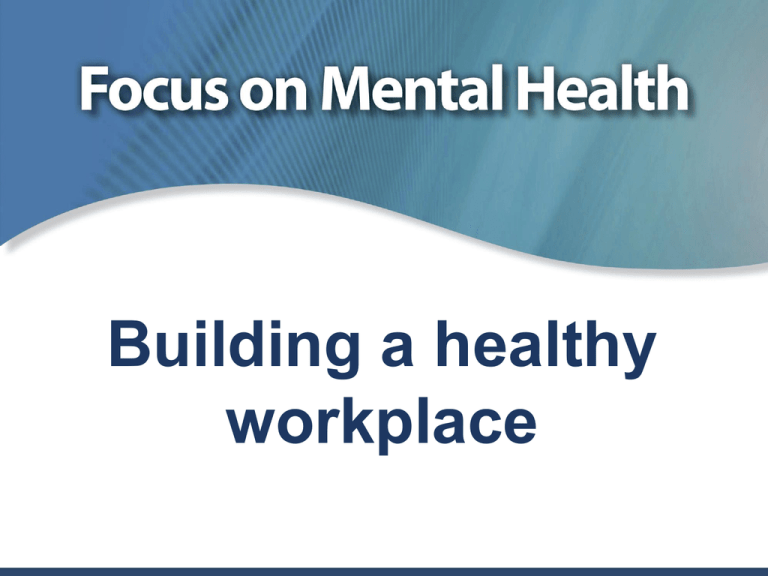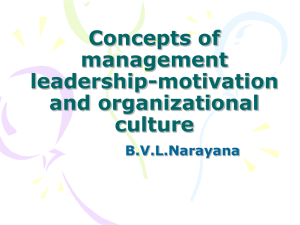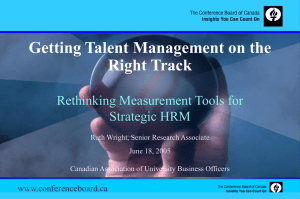Document
advertisement

Building a healthy workplace Karla Thorpe Director Leadership and Human Resources Conference Board of Canada Christine Hildebrand Director National Disability Claims Services Great-West Life Assurance Company Mary Ann Baynton Principal Mary Ann Baynton & Associates Consulting Building a healthy workplace Building Mentally Healthy Workplaces: Perspectives of Canadian Workers and Front-Line Managers Karla Thorpe Director Leadership & Human Resources Research Project Purpose The overarching purpose of this project was to: • Provide organizations with information to manage employee mental health and wellness • Identify challenges and successes faced by employees with mental health issues • Provide suggestions to ensure workplaces are supportive, healthy, and high-performing www.conferenceboard.ca Project Sponsors www.conferenceboard.ca Project Advisory Board • • • • Bell Canada Post Corporation Canadian Auto Workers Canadian Mental Health Association • Manulife Financial • Mental Health Commission of Canada • Mood Disorders of Canada www.conferenceboard.ca • Morneau Shepell • Public Service Alliance of Canada • TD Bank Group • Treasury Board • University Health Network • University of Calgary • University of Montreal Project Phases 1. Roundtable Consultation 2. Literature Review 3. National Survey of Employees and FrontLine Managers 4. Interviews with Employees and FrontLine Managers www.conferenceboard.ca Prevalence of Mental Health Issues I prefer not to answer Yes, currently 2% 12% No 54% Percentage of respondents; n=1,010 Source: The Conference Board of Canada www.conferenceboard.ca Yes, in the past 32% Profile • Mental illness affects people of all ages, educational and income levels, and cultures • Some groups more likely to report mental health issues: – Women – Non-managers – Not-for-profit sector – Unionized employees • Some groups less likely to report mental health issues: – Residents of Québec – People 65 years and older – Construction sector www.conferenceboard.ca What is a Mentally Healthy Workplace? Workload Work Scheduling Work-Life Balance • Workloads are monitored • “Face time” does not equal better job performance • Overtime is compensated • Flexible work arrangements exist • Work-life balance is promoted • Employees encouraged to take vacation • Employees not expected to respond to e-mail 24/7 www.conferenceboard.ca What is a Mentally Healthy Workplace? Work Environment • People are friendly, empathetic, understanding, and supportive • Bullying, harassment, and discrimination are not tolerated • Not a high-stress environment; no hostility or conflict Management Style • Managers are well trained and good people managers • Managers are not autocratic, authoritarian, controlling, and aggressive • Employees are not blamed or punished for mistakes Communication www.conferenceboard.ca • Open communication between management and employees • Human resource professionals and managers are approachable • Discussions are kept confidential Canadians’ Report Card on Mentally Healthy Organizations • 46 per cent of respondents agree their employer promotes a mentally healthy work environment • Perspectives differ by occupational category/level www.conferenceboard.ca Do Employers Promote a Mentally Healthy Workplace? Senior Executives 82 Executives 62 Management 46 Professionals - technical roles 45 Professionals - non-technical roles 41 Technicians/skilled tradespersons 40 Service, labour, and production 28 Clerical and support Percentage of respondents; n=1,010 Source: The Conference Board of Canada 45 0 www.conferenceboard.ca 10 20 30 40 50 60 70 80 90 Supervisors/Managers Have Confidence in Their Knowledge and Abilities • 81% of managers feel comfortable discussing mental health with their staff members • 81% feel that they could direct staff to appropriate supports www.conferenceboard.ca But Employees Don’t Agree…. • 29% believe their manager is knowledgeable about mental health • 32% would not feel comfortable talking to their manager about a mental health issue • 26% agree that their supervisor is able to “effectively” manage mental health issues • 32% feel that their supervisor would not be helpful if they were to approach them about a mental health issue www.conferenceboard.ca Training Received by Front-Line Managers No training or support received 44 Up to date knowledge of external and internal supports and resources available to all employees with mental health issues 33 Procedures or guidelines to follow if a direct report has a mental health issue 32 Training on how to recognize mental health issues in employees 18 Training on how to have conversations with employees regarding their mental health 17 Other Percentage of respondents; n=478 Source: The Conference Board of Canada www.conferenceboard.ca 2 0 5 10 15 20 25 30 35 40 45 50 Additional Training Front-Line Managers Want • Recognizing signs and symptoms • Community supports available • Medical factors influencing mental health issues • Strategies for keeping employees functional and successful in the workplace www.conferenceboard.ca • Responses to negative reactions • Insight into legal requirements • Handling difficult conversations • Softer skills • Creating an inclusive work environment Creating Positive Change in Organizations 1. Focus on education and communication to reduce fear, stigma and discrimination 2. Create a culture conducive to good mental health 3. Demonstrate leadership at the top 4. Provide the tools and training to support managers in their role www.conferenceboard.ca Contact Us Karla Thorpe Associate Director Leadership & Human Resources Research thorpe@conferenceboard.ca (613) 526-3090 ext. 408 Louise Chénier Research Associate Leadership & Human Resources Research chenier@conferenceboard.ca (613) 526-3090 ext. 305 www.conferenceboard.ca Building a healthy workplace Building a Healthy Workplace Focus on Mental Health 24 Building a Healthy Workplace – what have we done Guarding Minds@Work Focus on workplace values Leadership Development Great-West Life Centre for Mental Health in the Workplace 25 www.guardingmindsatwork.ca 26 A FREE resource to help employers answer: • Do we have a problem? • What are the causes of the problem? • What actions will help address the problem? • How do I assess the results? Available free at: www.guardingmindsatwork.ca For more information on this resource: www.workplacestrategiesformentalhealth.com ™Guarding Minds @ Work is a trademark of the Consortium for Organizational Mental Healthcare and is used with permission. 27 Includes: • A management assessment tool • A ‘quick assessment employee survey (6 questions) • A full employee survey (62 questions) • Templates on short-term and longer-term potential actions which can address specified risk areas • An evaluation guideline Available free at: www.guardingmindsatwork.ca For more information on this resource: www.workplacestrategiesformentalhealth.com ™Guarding Minds @ Work is a trademark of the Consortium for Organizational Mental Healthcare and is used with permission. 28 What you get: • A risk scorecard by 12 psychosocial risk factors for each ‘group’ surveyed and aggregated summaries Psychological Support Organizational Culture Clear Leadership & Expectations Civility & Respect Psychological Job Fit Growth & Development Recognition & Reward Involvement & Influence Workload Management Engagement Balance Psychological Protection ™Guarding Minds @ Work is a trademark of the Consortium for Organizational Mental Healthcare and is used with permission. 29 What you get: • By survey unit – specific counts re # of employees experiencing a mental illness, harassment, etc. • X% of employees reported experiencing discrimination because of their cultural/ethnic background, disability, sexual orientation, gender or age. • X% of employees believe they are suffering from a mental illness. • Of these, X% reported being treated unfairly in the workplace due to their mental illness. 30 What Great-West Life did • As early adopter, worked with researchers from the Consortium for Organizational Mental Healthcare (GM@W designed to minimize need for external support) • Appointed an internal project manager • Completed management audit and full employee survey 31 Results • Received detailed results organized by – Organization (e.g. Group Disability) – Office/city • Overall results were relatively positive – Generally showed moderate or minimal risk levels – A few pockets of significant risk 32 Follow Up Process for Great-West Life • Shared results with employees • Picked area(s) of concern and held staff focus groups • Reviewed solutions identified by focus group • Conducted one-on-one discussions and additional surveys • Created a Leader’s Guide with references and tips • Implemented solutions or specific actions to address low frequency but high impact issues – e.g. collecting feedback about leaders • Action planning has been completed – and is ongoing - at multiple levels 33 What Great-West Life learned • It’s not just the outcomes, it’s the process. This process to assess risk levels and engage in an ongoing dialogue directly between management and staff has many benefits – for the business – and for our people! • Engaging in dialogue with staff and building a healthy workplace involves significant management time – there is no free ride! • All of this was done with no change or provision in the expense budget! • We have a lot of strengths - GWL employees are engaged and customer focused 34 What Great-West Life learned • Problem areas were not always where we leaders thought they would be • Media etc. tend to focus on leadership, workload, and work-life balance as areas of concern. • Organization culture, civility and respect, and communication are prevailing areas of opportunity • Results can vary considerably by ‘unit’. We uncovered some surprises – including extremely positive results in some units and some ‘problem situations’ needing attention • Employees need to trust leaders if they are to bring forth concerns • Communication is KEY. We have a strong focus on communication, but needed to engage more in a dialogue with staff. 35 What Great-West Life learned • Leaders need to have a far better understanding of mental health aspects in the workplace • Our organizational values are aligned with the principles of a psychologically health workplace but our values were not deeply ingrained principles guiding our behavior or actions • Even with excellent corporate policies and support for employees in the areas of mental health, harassment and discrimination, staff may still not know what services/supports are available. Leaders need to reinforce policies and processes • Strong leadership is fundamental 36 Building a Healthy Workplace – Leadership Development Building trust Ensuring each employee understands their purpose Setting clear expectations Focusing on the most important priorities Creating a circle of accountability Growing and developing their employees Developing Emotional Intelligence Understanding mental health aspects in the workplace Literature, courses etc… GM@W GWL Centre for Mental Health in the Workplace 37 38 Mandate The Centre works towards preventing and reducing the impacts of mental health issues in workplaces by: • increasing knowledge and awareness and supporting knowledge exchange • helping turn knowledge into action. www.workplacestrategiesformentalhealth.com • A public service • Resources for employers • Incubator for innovative new tools 39 Building a healthy workplace One supervisor’s experience Accommodating violence? Triggers and Emotional Cost Who has your back? A Call to Action "When dealing with people, remember you are not dealing with creatures of logic, but creatures of emotion." - Dale Carnegie Building a healthy workplace











